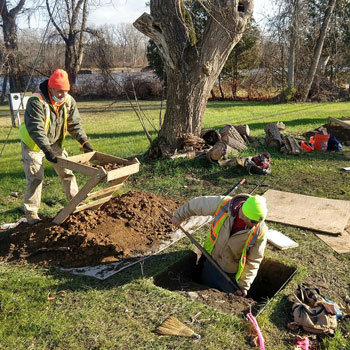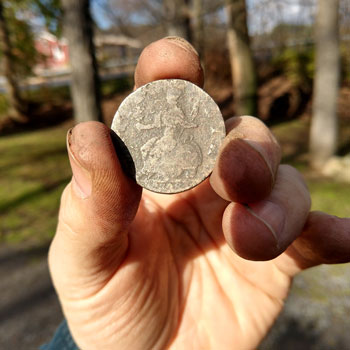
To help ensure its preservation, the state Department of Education created the Cultural Resource Survey Program (CRSP) in 1958 to help other state agencies meet historic preservation mandates. Staff dig deep into available research archives and conduct fieldwork to ensure planned projects don’t negatively impact cultural history.
PEF member Aaron Gore, a cultural education specialist with the Department of Education, explained how the process works.
“Say DOT wants to build a road, DOCCS wants to build a wing on a prison or DEC wants a new parking lot at a state park. There are federal and state statutes that surveys must be done in advance of those projects,” Gore said.
To prepare for site visits, CRSP staff scour period maps to get the lay of the land and guide their fieldwork.
“When we go out there and we do our excavation, we have a little bit of guidance where we might find artifacts,” Gore said. By digging a series of shovel test pits, circular holes about 30 centimeters across, staff take the soil out and screen it layer by layer.
“We look and see what’s in those layers, and we make our interpretation from that,” Gore said.
Based on historic records, one such project brought the team to a location in Saratoga County known to have been the site of locally prominent businessman Alvinza Finney’s house and store. The latter, known as the “Union Store,” served local residents and people traveling through the area by canal boat.
“Thousands of 19th century artifacts and a few below-ground features, including a stone and brick foundation for a small building likely relating to Champlain Canal activity, were uncovered during the excavation, consistent with earlier survey results,” Gore said. “However, archaeologists were not expecting to find significantly older objects, including a 1748 British coin and Native American items, including a resharpened projectile point, a sherd of decorated pottery, and chips from stone tool manufacture or resharpening.

“That is the nature of this work,” Gore said. “You never know what you’re going to get. You do research and go to a project area, and you expect to find something, but sometimes you find other things you didn’t expect. That’s what makes the job so exciting. The unexpected finds are generally pretty exciting.”
Gore’s lifelong interest in history drew him to this work.
“Ever since I was a kid, I was always really into history,” he said. “I was on track to be a historian. I grew up in a small town on the Canadian border and there was an 18th century French fort on a property in town. I had the luck to excavate that French mission, Fort de la Presentation, in Ogdensburg.”
“That was amazing,” he said. “We found all sorts of great stuff: gun flints, musket balls, a cool pipe bowl.”
Gore’s work with the CRSP takes him all over the state, traveling from the Canadian border to the far end of Long Island. Projects can be large, like the Exit 3 project on the NYS Thruway and the signage for Albany International Airport – others can be small, like a single building.
“It’s a great job,” he said. “It’s not just archaeology. We look at historic buildings, structures, bridges. All of these are considered cultural resources.”

